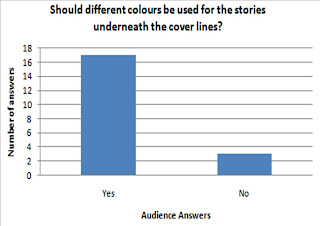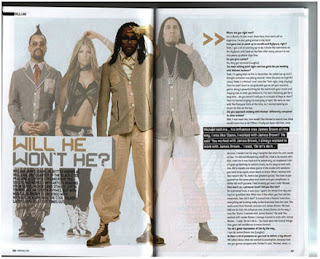These graphs represent the opinions of the general audience aged 16-19 within my area of how to create a music magazine that will meet its purpose with more success.
I handed out 20 questionnaires and received 20 questionnaires back so therefore the number of answers I receive back for each question should total up to 20.
The front cover
The graph above is regarding the front cover. As you can see the title on the graph is a query I have raised, and the available answers are "Yes" and "No". The result from this graph is the majority of people chose "Yes", however it is a narrow result, as it is a difference of 2 votes, and therefore it is not a completely clear set of answers.
The graph above is to do with the "appropriate amount of cover lines on the front cover". The answers available have a wide range which is; "1,2,3,4,5,6 and 7+". Giving this sort of wide range helps me to seek more precise results from this graph as I can find out the exact specific features that the audience want on this magazine. There is a clear answer available from this graph, and the clear majority chose "4" as the optimum amount of cover lines on the front cover of the magazine.
The graph above is concerning the "Main image on the front cover". There are 5 answers available and there are 3 answers that the majority have picked the most and they are approximately the same level. The "Solo Female Artist" has got the most votes, but very narrowly to the "Solo Male Artist" and the "Male Group" options.
The graph above is regarding the "Writing Colour beneath the cover lines" on the front cover. The available answers for the audience are "Yes" and "No". The result was clear as 17 of the 20 questionnaires received said "Yes". This therefore gives me a clear indication to use a different colour for the writing underneath my cover lines.
The graph above is regarding the "Title Font" and which style I should use for it. The available answers are; Seriff, San Seriff, Seriff + Bold and San Seriff + Bold. From a visual analysis of the graph, the font "San Seriff" seems to be the font being chosen most. The choice between using a bold font or not seems to be my decision as the audience answers are too close to clearly indicate a preference.
The graph above provides analysis of audience opinions on whether or not the title should overlap the main image on the front cover. The majority decision from the audience is yes, with 14 out of 20 people saying yes and therefore it is a clear indication.
The graph above is asking the audience what colour scheme they think will be best on a magazine. The majority vote by 3 votes to the nearest answer, with a total of 8 votes was Black, Red and White. Therefore, I will consider this type of colour scheme for my magazine
In the graph above, I have asked the audience what font they think would be best to use for cover lines, and the majority decision was Seriff + Bold which was 3 votes clear of the next closest answer.
The graph above provides analysis of the results regarding how many images should be used on the front cover. The majority decision with 14 out of 20 votes is to use 1 image on the front cover.
The graph above is about which front cover appeals most to the audience, and below I have provided the front covers that I used, and the majority decision with 9 votes is the Vibe magazine with Keri Hilson on as the main image.
Contents Page
The graph above is concerning how many images there should be on the contents page. The majority decision with 10 votes was 1 image.
Therefore I will use 1 image on the contents page as that's what the audience are asking for.The graph above is regarding the colour scheme between the title and background colour, and it asks whether the title should contrast or compliment the background. A majority of votes from the questionnaire was in favour of a contrast title, with 13 votes.
The graph above asks the audience whether I should continue the colour scheme from the front cover. A massive 19 out of the 20 votes were in favour of yes so therefore the answer from this graph is very clear.
The graph above concerns writing overlapping the images on the contents. The audience say yes or no, whether I should place writing on top of any images, and the graph is very conclusive, with a major 17 out of 20 votes saying no.
This graph above provides analysis for how many columns there should be allowed on the contents page for displaying articles and stories inside the magazine. The answers available are 1 column, 2 columns and 3 columns, and out of 20 votes, 2 columns was the most voted, with 14 votes and it is clear I should use two columns on my contents page.
The graph above is asking the audience about whether or not there should be an image on the contents page. Out of 20 votes, there were 19 votes in favour of Yes, so therefore I now know that the audience want an image on the contents page.
The graph above asks the audience whether I should use an image of the artist used on the front cover, and out of 20, 12 people said Yes, this is enough to say that most people want a picture of the same artist, but it isn't totally a unanimous result.
The graph above is asking the audience which contents page they preferred, and these contents pages have been provided below. And from the graph, there isn't a clear result. it is fairly spread and the top vote is 7 votes, which is both "Vibe - Keri Hilson" and "Vibe - Kanye". This is a bit complicated but it means I must pay attention to the design of Vibe magazine and that I can use either a male or female artist on my front cover with them both being equally liked.
Double Page Spread
The graph above is regarding how many images should be on the double page spread. The options available are 1 image, 2 images, 3 images and 4 images. The majority of votes picked 2 images, which got 12 votes out of a possible 20. Therefore, I will use two images on my double page spread.
The graph above is concerning the title overlapping any images on the page. The audience will reply saying "Yes" or "No". Out of a possible 20 votes, "No" got 12 votes so therefore it has received a majority of the votes, and I won't overlap the images with my title on my double page spread.
The graph above asks the audience where I should place my images, and it doesn't give clear answers. The most voted places were the "Centre of the page" and "Along the side". These answers were quite a way ahead of the other answers, so therefore I will place images in the centre and along the side of the page.
The graph above asks the audience whether the writing should overlap the images. And this graph isn't very conclusive, as No has 11 votes out of 20. Therefore it isn't a very large difference and perhaps I will have to make my own personal decision with this matter.
The graph above asks the audience whether or not I should continue the colour scheme from previous pages. The unanimous decision from the audience was to continue the colour scheme from both the front cover and contents, so to keep the colour scheme all the way through is what I will do with my magazine.
The graph above concerns what images I should use for the artist in the article. The audience mostly favoured using different and new images rather than the same images from the front cover and the contents page, so therefore I will use different images to suit what the audience want to see.
The graph above asks the audience which double page spread grabs their attention and the double page spreads I used are provided below. It was a balanced set of results. 3 of the 4 spreads were practically equally popular, which was "Lily Allen DPS", "Solange DPS" and "Black Eyed Peas DPS", and this means I will have to take tips from all 3 spreads on how to design my double page spread.




















































